In Judaism, nothing encompasses all those better than challah. We now think of challah as a delicious, rich braided bread, but the term challah refers specifically to a portion taken from the prepared dough.
I personally love kneading the ingredients by hand. I find doing so extremely meditative, relaxing and it feels so good! I get to breathe, think, and hope. I know it can become a difficult task to knead 5 pounds of flour (the minimum amount required to make a blessing during the separation of the dough) into dough, so if you own a bread-maker or a standing mixer with a dough hook and would like to use them, by all means, whatever makes you happier is best! Just note, that you can mix the ingredients in separate batches, but once mixed, you should put all the batches together into one mass to be able to separate the dough to make "challah."
Once the ingredients are mixed together, a pliable dough forms after kneading (due to the development of gluten, a now dissed protein, but the one and only capable of giving bread dough elasticity). Then, the challah is left to rise until it doubles its volume (time varies among recipes, but it could be about 1 to 2 hours), a blessing is recited (if 5 or more lbs of flour were used) and a piece (actual size varies according to authorities from the size of an olive to the size of an egg) from the whole dough is taken. That piece is The Challah. The required pause is a time that connects our human effort with G-d and His miracles, His gifts to us and His limitless powers. The moment of the separation distinguishes our humanity from His holiness, but also becomes a bridge that connects them both. Here's a great opportunity to access G-d, ask for a spouse, healthy children, good livelihood and/or good health. It's a moment that makes us aware of what we are doing, it makes us think about our lives and it's a time that can bring us together as a community. The power of the challah grows exponentially when separated by many people for a common cause. Please join me to make challah this week and include my friend's mother's name Diana bat Sophie in your prayer for a complete recovery.
The separated portion should be burnt (as a symbol of the challah that was given to the Priests in the times of the Temple).
Once the piece of dough has been taken, you can go ahead and focus on the esthetics of the loaves. A shiny golden challah is the perfect decoration for a beautiful Sabbath table, and can inspire everyone sitting around it.
Once shaped, you can wrap loaves up in plastic and freeze them. The freezer stops the rising process, but doesn't kill the yeast, so once the dough thaws, the rising continues. If you prefer, you can let the loaves rise a second time (about 45 min) and bake them in a 350 F oven. If it's late at night once you're done with shaping, no need to stay up waiting, just place shaped loaves in the refrigerator and let them rise overnight. The fridge slows down the rising but doesn't stop it completely.
Before baking, make sure your oven is preheated, brush challah with egg wash (if you want to), sprinkle it with toppings (again, up to you) and bake it. Here's comes the pleasure Marc David recommends: the smell wafting through your kitchen, a loaf that looks like a palpable miracle, tastes like glory and marks the rhythm of the weekly cycle. The fresh challah also carries along a story: your story, your hands, your creativity, your life, your thoughts and your prayers.
As for quality, making your own bread ensures you use no horrible artificial ingredients. You make something amazing out of very simple components, and that's why all the ingredients should be carefully chosen.
Then, the challah loaf is blessed, the bread is broken with friends and family, and who doesn't get excited by the first bite? Suddenly, everything seems happier, tastier, better. And then, at the end of the meal hailed by the challah bread, another blessing, this time, a special song of gratitude.
In a nutshell: challah is, an opportunity to feed our spirit, our bodies, most of our needs and connect with G-d through a tasty loaf of relaxation, quality, awareness, rhythm, pleasure, thought, story and the Sacred.
Here's a challah recipe I like, but feel free to use your favorite one. The internet and many cookbooks have tons of them. Your choice.
And please, please comment, ask or add on to this post in The Irony of Baking's FB page at: https://www.facebook.com/eatyourcakeandeathealthytoo
CHALLAH
4 cups (960 ml) lukewarm water
8 teaspoons dry yeast (3 1/2 packets)
1 tablespoon honey
5lbs bread flour (all-purpose flour or white whole wheat flour can be used instead, try using organic)
1 1/2 tablespoons fine sea salt
1 1/2 cups honey (I like using local honey from the farmer's market)
5 large cage-free eggs (2 of them separated and egg whites reserved)
1 1/2 cups plus 2 tablespoons expeller pressed safflower oil (evoo, sunflower seed, rice bran, avocado or melted organic coconut oil can be substituted)
Additions:
-1 tablespoon culinary grade lavender, crushed
-Sesame, poppy, flax or chia seeds for topping
-1/2 cup raisins and/or dried cranberries, cacao nibs or chocolate chips
BEFORE YOU GET STARTED, MAKE SURE YOU KNOW THIS ABOUT WORKING WITH YEAST:
- check expiration date on yeast
- treat yeast like a baby: test the water temperature for activating the yeast with the inside of your wrist, and if you'd bathe a baby in it, then it will work for the yeast. If in doubt, err on the colder side, as it would slow down the process, but water that's too hot would kill it
- yeast loves sweetness, so add 1 tablespoon of honey (or sugar) into the water for activating
- use a glass, ceramic or plastic bowl or cup to activate yeast. Metal may inhibit the process (trust me, it's happened to me)
- if the sweetened warm water and the yeast don't start bubbling after 5 minutes, toss the yeast and run to your nearest Food Emporium to get a new package
1. Dissolve yeast in the lukewarm water with 1 tablespoon honey. Set aside.
2. In a huge bowl (or 2 large ones), mix flour and salt with a spatula or wooden spoon. Make a well in the center.
3. Pour into the well the remaining honey, the 3 eggs and two yolks, 1 1/2 cups oil and the activated yeast mixture (that should be bubbly and dense). Mix with a spatula and then knead, preferably with your hands, until the dough is elastic, and if you press it with a finger, the indentation disappears soon after it's made (it should bounce back). If using any additional ingredients like lavender or raisins, add at this point.
4. Combine all the dough if it was mixed in separate batches.
5. Cover dough with remaining oil all around, including the bottom and place back in its bowl. Cover bowl with plastic wrap or a moist kitchen towel and let to rise in a warm place until it doubles its volume (about 1:45 hour to 2 hours). Go to your spinning class, catch up on your email or make dinner, but make sure you set a timer (I usually ask Siri to tell me when the time has passed).
6. Now the most important part: separate the challah with a blessing, and be really aware of what you are doing to make the best of this special moment. Remember to add Diana bat Sophie into them!
7. Shape the challah (see tips below). Cover loaves loosely with plastic and let them rise again for about half hour.
8. Preheat oven to 350 F.
9. Brush loaves with the reserved egg whites, and sprinkle with seeds, if using
10. Bake until golden brown and when bottoms of challahs sound hallow when tapped. Time will depend on the size of the loaves made.
Enjoy your hard work, your connection with G-d, the good fortune of your prayers and the most special of foods...
VARIATIONS:
*GLUTEN FREE CHALLAH:
Substitute flour with 5 lbs of GLUTEN FREE OAT FLOUR mixed with 3 TABLESPOONS xanthan gum. Note that without gluten, dough will be hard to shape into braids. I have one of these challah molds to do the trick!
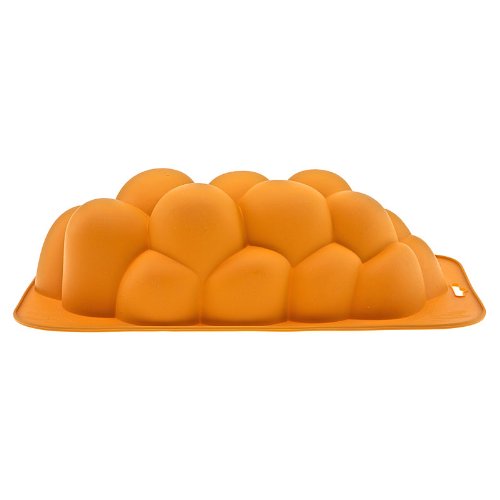
*EGG FREE CHALLAH:
Omit eggs OR add instead 3 TABLESPOONS flax meal mixed with 9 tablespoons water
BLESSING FOR THE SEPARATION OF THE CHALLAH (you can say it in Hebrew, English or whatever language you want) From Chabad.org
Hebrew:


Transliteration:
BA-RUCH A-TAH A-DO-NOI ELO-HAI-NU ME-LECH HA-O-LAM A-SHER KID-SHA-NU B'MITZ-VO-TAV V'TZI-VA-NU L'HAF-RISH CHAL-LAH
BA-RUCH A-TAH A-DO-NOI ELO-HAI-NU ME-LECH HA-O-LAM A-SHER KID-SHA-NU B'MITZ-VO-TAV V'TZI-VA-NU L'HAF-RISH CHAL-LAH
Translation:
Blessed are You, L-rd our G-d, King of the Universe, who has sanctified us with His commandments and commanded us to separate challah.
Blessed are You, L-rd our G-d, King of the Universe, who has sanctified us with His commandments and commanded us to separate challah.
Burn the challah by wrapping it in a piece of silver foil ands placing it in the broiler, or by any other method. (If burning it inside the oven, there should be no other food baking in the oven at the same time.)
SHAPING CHALLAH:
Here are some suggestions, but visit The Challah Blog if you want more specifics:
http://www.thechallahblog.com/p/shapes-at-glance.html
-You can make traditional 3-stranded braids, or could make each loaf by making a large braid and placing a smaller one on top lengthwise.
 |
| From http://culinarykosher.com/cooking-videos/wp-content/uploads/2012/10/Simcha-Challah.jpg |
-No time or patience? you can make an impressive challah by shaping portions of dough (whatever size you want) into balls and throwing a bunch of them in a cake or loaf pan. There you have pull-apart challah.
 |
| From http://chickinthekitchen.com/2012/02/13/pullapart-challah-rolls/ |
-I like making 4-stranded challahs, you just remember to go: "over, under, over" from right to left, and then starting over with the strand to the left.
-My favorite these days is Smitten Kitchen's round challah method that looks gorgeous and is so easy.
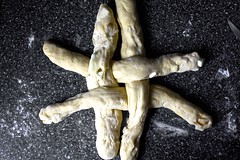
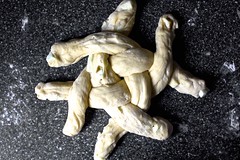
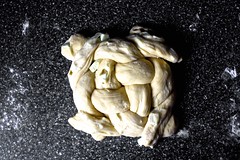
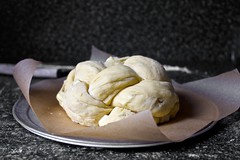
From: http://smittenkitchen.com/blog/2011/09/apple-and-honey-challah/
